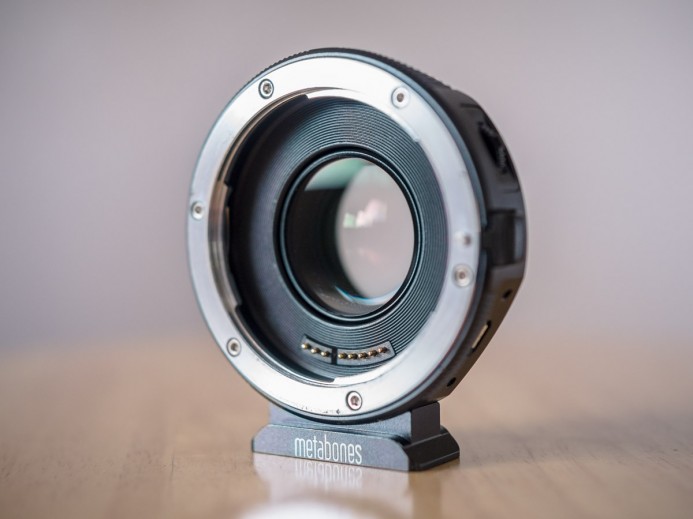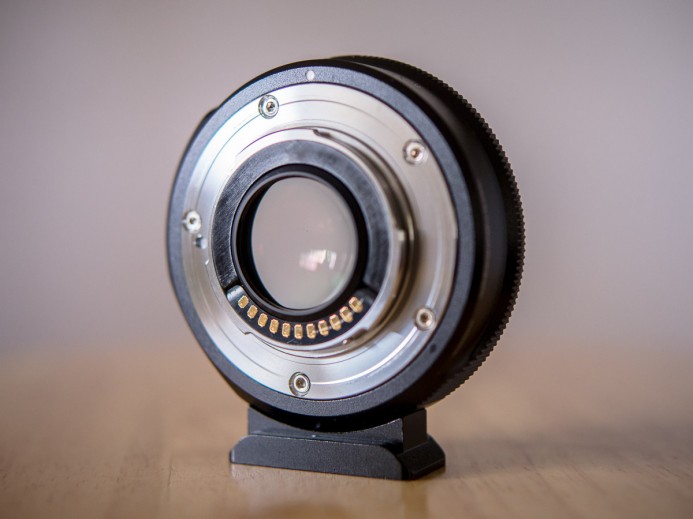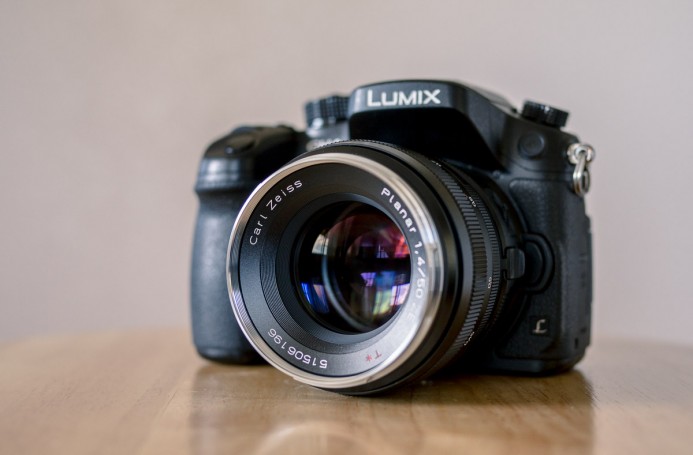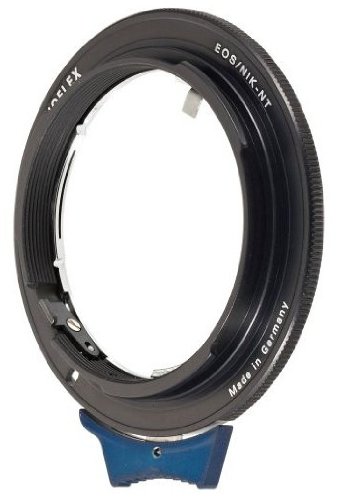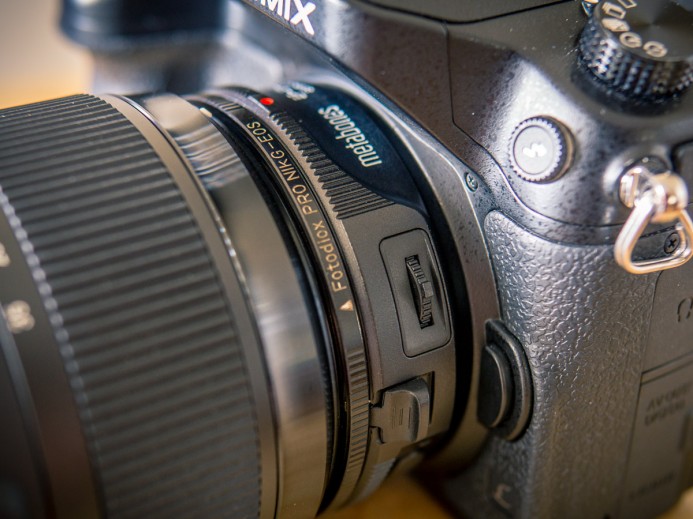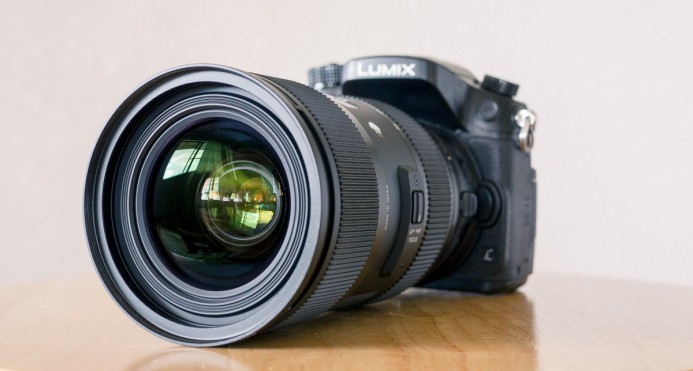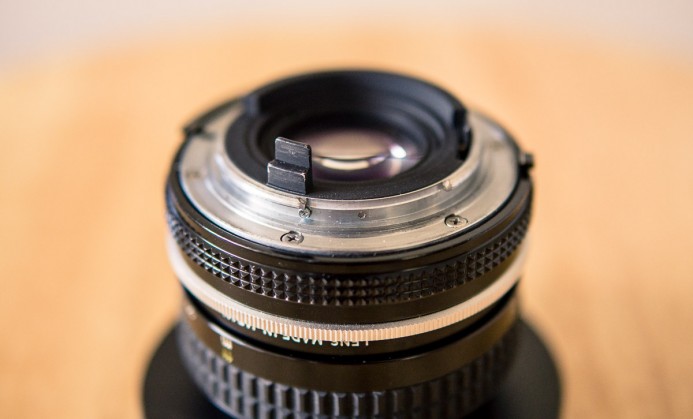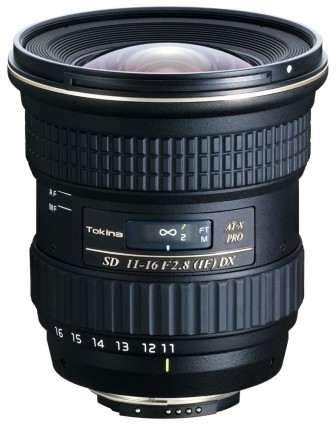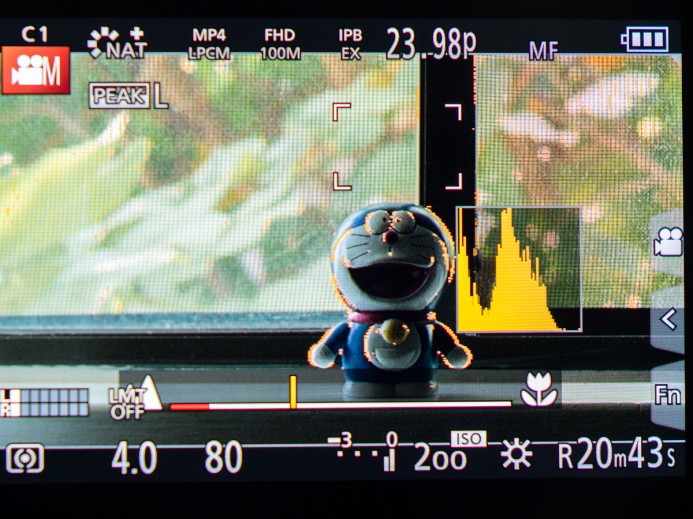7 Days with Metabones’ Canon EF Speed Booster
Metabones’ highly-anticipated Speed Booster adapter for Canon EF lenses has been released and is now out in the wild. Is it the lens adapter for you’ve been waiting for?
I rented the Metabones EF Speed Booster for a week to use with the Panasonic GH4 on a variety of projects. Here are some notes and observations on the EF Speed Booster after a week of heavy video production.
Just the Stats Ma’am
- Adapter Type: Active (Electronic)
- Lens compatibility: Canon EF
- Camera compatibility: Micro Four Thirds (Panasonic GH4, etc.)
- Focal Reduction: 0.71x
- Aperture Control: Yes (in-camera)
- Autofocus: Yes
- Image Stabilization: Yes
- Price: $599
A is for Active
The EF Speed Booster is an active adapter, which means it contains electronics that allow the camera to communicate with electronically-controlled Canon EF-mount lenses.
There are already a bunch of inexpensive passive Canon EF lens adapters, but only an active adapter provides essential lens functionality such as aperture control.
Bottom line: For full EF lens functionality, an active adapter is the only option.
(Aperture) Adjustment Period
Controlling an EF lens’ aperture via the GH4’s in-camera controls just like a native lens is a surprisingly pleasant experience. The EF Speed Booster provides precise control over aperture, which is important for matching lens settings across different shots and takes. Knowing exactly what aperture the lens is set to is very nice.
Note: Since the EF Speed Booster’s custom-designed optics draw in an extra stop of light, the adapter adjusts the aperture value that is reported to the camera by 1 stop as well. This means that if your lens has a maximum aperture of f/2.8, it will actually show up as f/2.0 when wide open.
However, because some cameras freak out with aperture readings below f/1.0, Metabones have opted not to shift the aperture values for lenses with a maximum aperture of f/1.4 or wider. For these lenses, the aperture reading is the original aperture. Yes, it is confusing, but that’s the way it is.
I thought I would miss the manual clickless aperture ring you get with Nikon G-mount lens adapters, which allows you to subtly adjust the aperture mid-shot. However, unless the adapter’s aperture ring has a nice long throw, a manual aperture ring isn’t as useful as you might think.
In reality, many Nikon G-mount adapters barely give you 15 degrees of adjustment from wide open to fully closed on the aperture ring. This makes small aperture adjustments (e.g. from f/1.4 to f/1.8) difficult to say the least.
Bottom line: If you want clickless aperture control, use a cine lens. Otherwise, the EF Speed Booster’s in-camera aperture control provides the precision you need.
Going Steady with Image Stabilization
Another nice benefit of this active EF lens adapter is that it also activates a lens’ built-in image stabilization functionality. This can come in handy when working with longer focal lengths and you’re caught without even a minimal camera rig or monopod.
I did not have a chance to use the EF Speed Booster with any IS lenses over the past week, but this is something I’m hoping to test in the near future.
Bottom line: IS is another nice tool you get with the EF Speed Booster.
Increased Field of View & Brightness
The EF Speed Booster features custom-designed optics that increase the field of view and brightness of lenses mounted on the adapter.
FOV Calculation
The Speed Booster’s optics provide a 0.71x focal reduction factor, which you apply to a lens’ focal length to calculate the new FOV.
For example, a 50mm lens will have the same FOV as a 35mm lens (50 x 0.71 = 35.5) mounted on the camera with a standard adapter.
Boosted Brightness
The wider FOV is nice, but it’s nothing that a few steps backward can’t accommodate for many situations. On the other hand, the increased brightness is useful in any situation. The difference in brightness between the Speed Booster and a standard adapter is dramatic.
Bottom line: Wider FOV is nice, but the increased brightness provided by the Speed Booster is unparalleled.
Image Quality
The Speed Booster’s optical quality is good, even for still photography.
I’ve been shooting a lot and haven’t had a chance to closely evaluate details like corner performance, chromatic aberration, and coma, but no big issues have jumped out when reviewing shots so far.
It also doesn’t hurt that I’ve been shooting with the Zeiss 50mm f/1.4 ZE Planar T* lens with the EF Speed Booster.
This lens is slightly soft wide open, but sharpens up considerably when stopped down to f/2.0, which just happens to be my sweet spot for 50mm lenses.
Bottom line: The EF Speed Booster maintains solid image quality.
Build Quality
Metabones is known for building solid lens adapters and the EF Speed Booster is no exception. Everything from the metal lens & camera body mounts down to lens release button feel robust and well-built.
There will usually some play between the camera and an adapter, so I’m glad to say that play between the GH4 and the EF Speed Booster is quite minimal (no worse than a native lens).
The connection between lenses and the EF Speed Booster is even more rigid, making the lens & adapter feel like a single unit. With the Speed Booster’s optics in the rear, it feels like you’re mounting a native lens, rather than a lens and adapter.
Bottom line: The EF Speed Booster is solidly built.
Compatibility
The EF Speed Booster is compatible with both full frame and APS-C EF lenses, providing you with a vast array of lenses to choose from.
Note: Canon EF-S mount lenses are not compatible with the EF Speed Booster because the mount extends further out and comes into contact with the Speed Booster’s optics.
Using Nikon Lenses with the EF Speed Booster?
Nikon and Canon both make great lenses, but because of incompatible lens mounts, you need to choose one or the other.
Or do you?
One of the things I wanted to test was how well using an adapter to mount Nikon lenses on the EF Speed Booster would work.
I generally do not recommend stacking lens adapters because things can go downhill very quickly. Flange distance tolerances so tight that it only takes a few microns to affect a lens’ ability to focus properly. On top of that, every new connection can introduce additional play between the lens and the camera, which can cause the lens to shift in the mount. However Metabones’ EF Speed Booster fit so well on the camera that I decided to give it a shot.
And it worked surprisingly well.
Of course, there is no electronic communication between the EF Speed Booster and Nikon lenses, so lens control is fully manual (IS, aperture, focus, etc.). However, the thin Nikon to EF adapter has a small lever that allows you to control the aperture on lenses without manual aperture rings (e.g. Nikon G-mount lenses). The lever’s range is short so you don’t have a very fine control over aperture, but aside from that, this adapter allows you to effectively use both Canon EF-mount and Nikon G/F-mount lenses with the EF Speed Booster.
Your lens options just went through the roof.
Unfortunately, not all Nikon-mount lenses are compatible with the Speed Booster. For example, the rear of the Nikon 50mm f/2.0 AI has a protruding tab that keeps it from mounting with the Speed Booster. Some surgery may be in this lens’ future.
Bottom line: Native support for all EF-mount lenses and surprisingly good support for Nikon F/G-mount lenses (with an adapter) make the EF Speed Booster pretty versatile indeed.
Vignetting
Since the Speed Booster’s optics reduce the GH4’s crop factor to 1.42x (from 2x when shooting HD), there may be some vignetting on wide-angle APS-C lenses that have a very tight image circle (Canon’s APS-C cameras have a 1.62x crop factor).
I tested the EF Speed Booster with the Sigma 18-35mm f/1.8 and Tokina 11-16mm f/2.8. If vignetting was present with either of these wide-angle lenses, it wasn’t heavy enough to be a distraction.
Tokina 11-16mm f/2.8
The Tokina 11-16mm f/2.8 is an interesting lens for use with the Speed Booster. When paired with the Speed Booster, this lens’ FOV matches a 7.8-11.4mm lens. This is pretty close to Panasonic’s 11-14mm f/4 lens, except that the Tokina lens would be 2 stops brighter (4 times brighter).
The Tokina 11-16mm f/2.8 could be an affordable option for shooters requiring a wide-angle rectilinear (non-fisheye) lens for low-light situations. I’ll be comparing this lens to the Panasonic 7-14mm f/4 in a future post.
Bottom line: Heavy vignetting was not apparent even with wide-angle APS-C lenses, but more testing is required.
Stay Focused
The EF Speed Booster supports autofocus when used with Panasonic cameras such as the GH4. However, autofocus functionality is currently optimized for still photography, rather than video production. Notably, autofocus is not available when shooting 24P video.
That said, manual focus is generally preferred when shooting video anyway. Fortunately, the GH4 has excellent focus aids such as focus peaking, that make manual focus a breeze. Focus peaking highlights the parts of the frame that are in focus with colored outlines so that you can quickly nail focus while shooting.
Quick Tip: Make sure that the GH4 and the lens are both set to Manual Focus to enable focus peaking.
It would be nice if AF were supported when shooting 24P video, but the lack of AF on the EF Speed Booster isn’t that big of a deal for video work because you should be focusing manually anyway. I for one am glad that Metabones have released the EF Speed Booster now rather than wait until they got AF working across the board. Even if autofocus isn’t optimized for video, at least it will be useful for grabbing a couple stills between takes.
Bottom line: Autofocus works in some video modes and not others, but future firmware updates may improve performance.
Should You Get the EF Speed Booster?
After renting the EF Speed Booster for just 7 days, I am tempted to buy one and have it live on the GH4. The image quality, wider FOV, increased brightness, and lens compatibility (Canon and Nikon) make the EF Speed Booster a very useful tool.
If you are heavily invested in EF lenses, there is no question– Metabones’ EF Speed Booster is the adapter you’ve been waiting for. I don’t currently own any EF lenses, but I am eyeing several EF lenses for upcoming projects, so the EF Speed Booster may find its way back onto my GH4 sooner rather than later.
Free Consult
Do you like the idea of using the Speed Booster with the GH4 but aren’t sure if it will work for your specific needs, or which lens to get for the Speed Booster?
The GH4 was already versatile and the Speed Booster takes things to an whole new level.
I’ve been shooting on Panasonic’s GH-series cameras for several years and I want to help you find your bearings quickly so you can get back to shooting awesome stuff! That’s why I’m currently offering free consults to help answer your questions.
Related
- Metabones Canon EF to MFT Speed Booster
- Novoflex Nikon G to Canon EF Adapter — Mount Nikon lenses on the Canon EF Speed Booster.
- Fotodiox Pro Nikon G to Canon EF Adapter — Budget-friendly adapter for mounting Nikon lenses on the Canon EF Speed Booster.
- Zeiss ZE 50mm f/1.4
- Tokina 11-16mm f/2.8 II
- Panasonic DMC-GH4
Lens Options for the Panasonic GH4
Introduction
- Micro Four-Thirds: Introduction & Overview
- Using Native Lenses
- Using Adapted Lenses
- How to Choose Your First Lens
Canon EF Lenses
- Using Canon EF Lenses
- Review: 7 Days with Metabones’ Canon EF Speed Booster
- Speed Booster Showdown: Canon EF vs Nikon
- PSA: Canon EF-S is not the Same as APS-C
Prime Lenses
- 5 Reasons You Should Be Using Prime Lenses
- 9 Awesome Prime Lenses (Wide Angle to Telephoto)
- Essential Prime Lenses for Your Documentary
Zoom Lenses
- 4 Reasons Zoom Lenses are Awesome for the Panasonic GH4
- Lens Throwdown: Panasonic 12-35mm f/2.8 vs Olympus 12-40mm f/2.8
Buying Guides
More Panasonic GH4 Guides
- Why You Should Be Excited About the Panasonic GH4
- Lenses for the Panasonic GH4 — Awesome glass for an awesome camera.
- Memory Cards for the Panasonic GH4 — Get the right memory cards for HD and 4K.
- Configuring the Panasonic GH4 for Video Production — Set the GH4 up for filmmaking.
- Rigging the Panasonic GH4 — Cages, Rigs, Components, Gear, and Reviews.
- Stabilizing the Panasonic GH4 — Tripods, Monopods, Sliders, 3-Axis Gimbals, etc.
- Maximizing the Panasonic GH4’s Audio Performance — Sound matters.
- Powering the Panasonic GH4 — Keep the GH4 shooting all day.
- Should you buy the YAGH for the Panasonic GH4?
- 6 Reasons Why DSLR Shooters Love the Panasonic GH4

